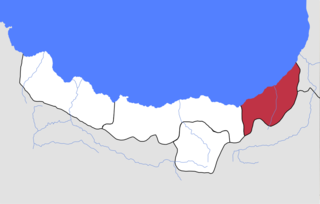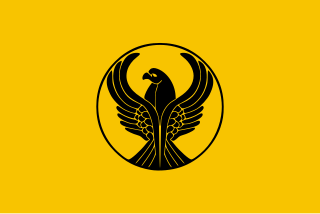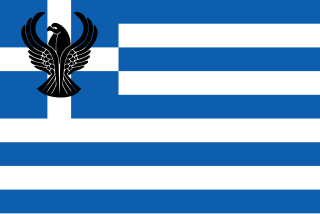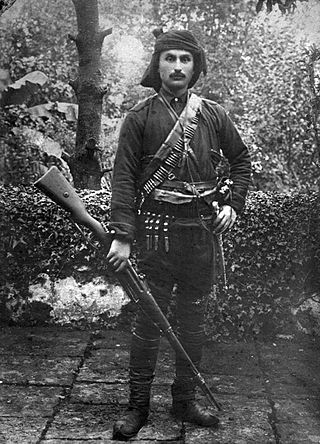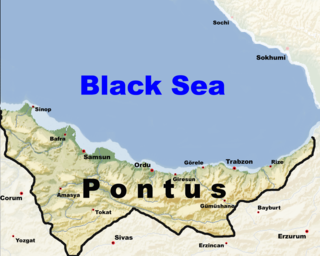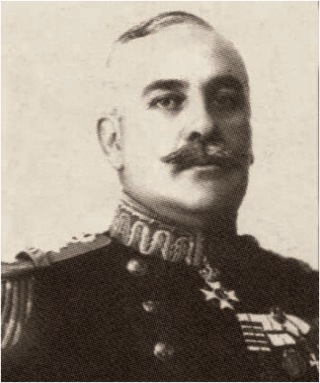Campaign of extermination

During late spring of 1921, the activity of armed bands led by Topal Osman included looting, burning of Greek settlements around Samsun and massacre of the civilian Greek population. The rest of the population was deported to the interior of Anatolia. [7] Although not allowed out of Samsun, American relief workers observed the nearby village of Kadikeuy being systematically looted. Its residents as well as those from other villages fled to the city of Samsun to find refuge. [8] Due to his activity, Topal Osman was portrayed as a "national hero" by the Turkish press in Ankara and Constantinople. [9] Meanwhile, the commander of USS Fox which was stationed off Samsun, reported that c. 100 surrounding Greek villages were destroyed, their inhabitants killed and the priests were crucified. As a result, the United States High Commissioner in Istanbul, admiral Mark Lambert Bristol, immediately filled a protest against the Turkish officials of Samsun. [10]
In the last week of May 1921, bandits of Topal Osman swarmed into Samsun itself. [2] On June 16, the Turkish nationalist government of Ankara authorized the deportation of all Greek males between ages 16 and 50 who remained in Samsun. The deportations were carried out by Turkish General Nureddin Pasha, [11] while massive arrests of the local Greek population begun the same day. [12] Meanwhile, the commander of USS Overton stationed off Samsun reported to admiral Bristol that the deportations would be carried out quickly and that a large number of the deportees would die as a natural consequence. [13] Most of the gendarmes who were supposed to accompany the deportees were former criminals and were acting in collaboration with Turkish irregular band leaders. [14] On June 17, the first group of 1,040 men was deported. They were marched to the town of Kavza, c.46 kilometres (29 mi) south of Samsun, where they were massacred by the band of Topal Osman. In another death march on June 21, a total of 1,085 men were deported from Samsun. After a 4-hour march they were ambushed by a group of Topal Osman, who massacred c. 700 of them. [12]
American Near East Relief workers in Samsun determined that all the deportees "were being sent to their deaths" while also observing the impunity with which Turkish irregular bands were committing murders on the streets of Samsun, as well as investigated the Christian residences. As a result, the Near East Relief orphanage at Samsun was flooded with Greek children from the region. [10] A commission of US navy officers visited the Samsun Mutasarrif. The latter claimed that the deportation order was already in effect and admitted that many of the Greek men who had been deported earlier had been killed. [15] Admiral Bristol protested the deportations to the Turkish nationalist government based in Ankara. [16]

Most deportees were marched via Amasya and Sivas to Harput, and from there to Diyarbakir, Bitlis, and Van. [17] As a result of the deportations that were ordered in June, nearly 21,000 people were forcefully deported from Samsun. [11] In early September 1921, 1,500 women and children from nearby Greek villages who had recently found temporary refuge in Samsun were deported. A similar deportation was undertaken against c. 6,000 women and children from the adjacent Bafra district. [18]
American relief worker Edit Wood, on his way from Samsun to Harput, noted:
Bodies lay along the roadside and in the fields everywhere. There was no hope for the Greeks from Malatia to Samsun, and the most fortunate were those who perished at the start. [19]
In mid-November 1921, 700 women and children who had earlier fled to the hills returned to Samsun for fear of cold due to the approaching winter. The Turkish authorities did not hesitate to deport them altogether. Some reactions by the head of the Near East Relief to stop at least part of the deportation were ignored by the local Turkish governor. In April 1922, the commander of the USS Fox, William Leahy, reported that an additional 1,300 Greeks were sent out from Samsun, mostly women and children, but also a few old men. [20]



